#EmployerBrand
Text
Brandemix: Employer Brand Refresh & Marketing
Brandemix explains how leveraging the expertise of your marketing team can enhance your employer brand, and attract top talent.
0 notes
Text
How to Build and Manage a Talent Pool for Your Business
What Does ‘Talent Pool’ Mean?
A talent pool is a collection of potential candidates that can help your business grow and achieve its long-term goals. A talent pool can include both internal and external candidates, such as second-choice applicants, former employees, employee referrals, career fair attendees, and social media contacts. Having a talent pool can help you hire more strategically, quickly, and resiliently, as you can tap into a reservoir of talent whenever you need it. Now, you may be wondering how a talent pool differs from a talent pipeline.
Talent Pool vs. Pipeline
While the two terms are often used interchangeably, a talent pipeline typically refers to a more structured and proactive approach to recruitment. A talent pipeline is often used by larger organizations that have ongoing hiring needs, while a talent pool is more of a passive approach.
How To Create a Talent Pool
1. Define your talent needs
Before you start building your talent pool, you need to have a clear idea of what kind of skills, experience, and qualifications you are looking for in your future hires. You can use your workforce planning strategy, your current job descriptions, and your market research to identify your talent needs and gaps.
2. Source your candidates
Once you know what kind of candidates you want to attract, you need to find them and engage them. You can use various sourcing methods, such as posting on job boards, reaching out on social media, attending networking events, asking for referrals, or using specialized software solutions. You can also use an applicant tracking system (ATS) to keep track of your candidates and their profiles.
3. Segment your talent pool
Having a large talent pool is not enough; you also need to organize it and segment it according to different criteria, such as role, skill set, location, availability, or interest level. This will help you tailor your communication and outreach strategies to each segment and increase your chances of converting them into applicants.
4. Communicate with your talent pool
One of the most important aspects of managing a talent pool is keeping in touch with your candidates and maintaining their interest and engagement. You can use various communication channels, such as email, phone, text, or social media, to share relevant information about your company, your culture, your values, and your opportunities. You can also invite them to webinars, podcasts, newsletters, or surveys to provide value and feedback.
5. Evaluate and update your talent pool
Finally, you need to monitor and measure the performance of your talent pool and update it regularly. You can use metrics such as open rates, click-through rates, response rates, conversion rates, or quality of hire to assess the effectiveness of your talent pool strategy. You can also use feedback from candidates and hiring managers to identify areas of improvement and make adjustments accordingly.
READ MORE....
#TalentAcquisition#HRStrategies#RecruitmentTips#WorkforceManagement#HRBestPractices#StaffingSolutions#TalentManagement#HiringStrategy#EmployerBrand#HRInsights#TalentPipeline
0 notes
Text
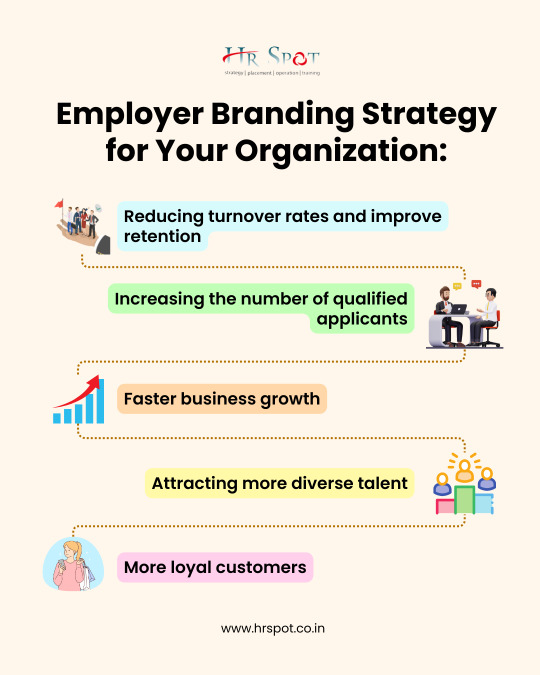
To stay competitive and attract the greatest employees available, companies worldwide are always improving their employer brands. Employer branding has developed from being viewed by many as merely a marketing phrase to becoming a crucial component of a company's strategy.
0 notes
Text
The Powerful Impact of Candidate Experience
1 note
·
View note
Text
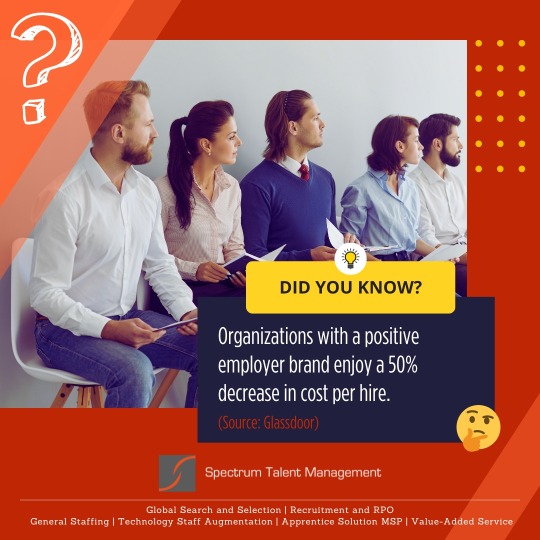
Did you know that organizations with a positive employer brand enjoy a 50% decrease in cost per hire?
Invest in your employer brand today to attract exceptional talent and optimize your hiring budget.
#EmployerBrand#TalentAcquisition Recruitment#HireTopTalent#CompanyReputation#HRSolutions#SpectrumTalent#SpectrumTalentManagement
0 notes
Photo

Glassdoor is not just another job search website - it's a powerful platform that empowers both job seekers and employers. With over 55 million monthly visitors, Glassdoor offers valuable insights into company culture, salaries, and employee reviews. Employers can create a compelling profile and respond to reviews to build a positive reputation and attract top talent, while job seekers can find their dream job and take the next step in their career. So why settle for anything less? Join the Glassdoor community today and unlock endless career opportunities!
#glassdoor#jobsearch#careersuccess#employerbrand#company#companyculture#salaryinsights#employeereviews#careeropportunities#jobhunting#careergrowth
0 notes
Text
2 notes
·
View notes
Photo

Top Manpower Services in Mumbai
Acquire the right manpower for your company by approaching PlacementIndia.Com. This portal is the hub for searching and acquiring manpower services in Mumbai. All service providers registered with us assert the provision of the unmatched corporate manpower in Mumbai owing to the experience and expertise of the workforce. By turning to PlacementIndia.Com, several industries have already found their manpower solutions in Mumbai.
#PlacementIndia#manpowerservices#employerbranding#recruitment#recruiting#humanresources#branding#candidateexperience#recruitmentmarketing#dreamjob
1 note
·
View note
Text
Was Arbeitgeber wirklich attraktiv macht. Zu Gast im Linkedin Live bei Samir Ayoub
Es ist eine der wichtigsten Fragen in der deutschen Wirtschaft. Nahezu alle Unternehmen beschäftigen sich damit, wie sie als Arbeitgeber attraktiv werden – für die Mitarbeitenden und für die, die es noch werden sollen.
Im Gespräch mit designfunktion CEO Samir Ayoub durfte ich meine Insights dazu teilen. In mehr als 200 Episoden meines Podcasts “New Work Chat” und eigenen Projekten als Berater…

View On WordPress
#Arbeitgeberattraktivität#designfunktion#Employerbranding#Fachkräftemangel#New Work#Samir Ayoub#Social Media
0 notes
Text

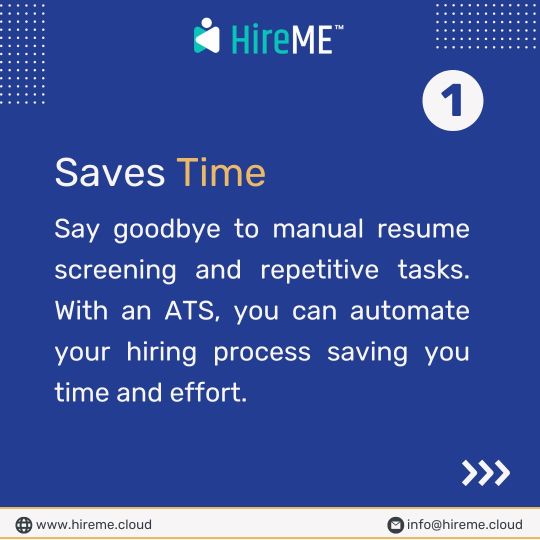


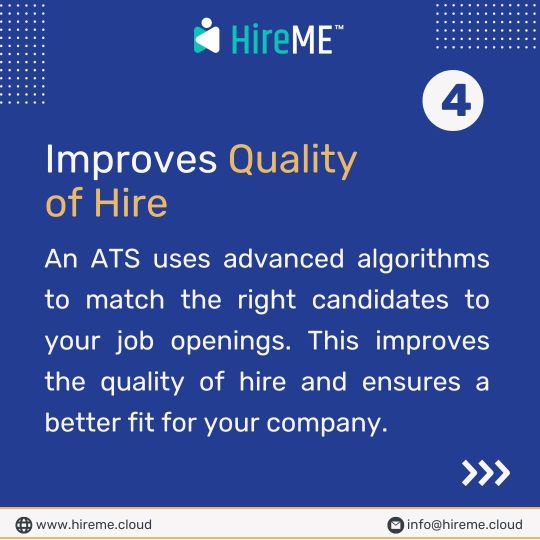



An Applicant Tracking System (ATS) is a must-have tool for today's hiring needs. Here are 5 reasons why you should consider using an Applicant Tracking System:
1- Saves time
2- Reduces cost per hire
3- Improves quality of hire
4- Boosts productivity
5- Builds strong employer brand
Ready to upgrade your hiring game? Try HireME ATS now! Get started with a 15-day free trial: https://www.hireme.cloud/contact-us
#HireME#applicanttrackingsystem#ats#atssoftware#recruitment#hiring#employerbranding#recruiting#talent
0 notes
Text

HR team must try to build a unique voice and brand of your own. They should work to create a differentiated employer value proposition that can be seamlessly integrated internally or externally such as your campus programs or social media. Click to know more about employer branding activities
0 notes
Text
youtube
Brandemix Bonus Reel: The Importance of One Brand
Jason Ginsburg, Director of Interactive Branding at Brandemix, explains why organizations should integrated their employer brand with their consumer brand -- and how to do it right.
0 notes
Text

Hire with Confidence: Pay Only for Results with HR Armat! 🎯
Are you in search of a dependable partner to recruit top-quality professionals? HR Armat offers "success-based payment" recruiting services! You only pay when you make a successful hire, with our fee being 25% of the new employee's first salary. This means you save on initial costs while we take on all the risks of the search. 🌟
Our services include:
Talent Search and Recruitment: We handle the entire process, from defining vacancies to screening candidates. 🕵️♂️
Employee Assessment and Development: Build your dream team with our evaluation programs and career planning services. 💼
HR Consulting and Outsourcing: Get professional advice and delegate routine tasks to us, so you can focus on growing your business. 🚀
Legal Support and Labor Market Analytics: Stay ahead of the latest trends and changes with our expert guidance. 🔍
We're ready to discuss the details and craft the perfect candidate profile for your business. Contact us today to start with a team of over 20 experienced recruiters. Visit our website [https://hrarmat.com/] for more information.
With HR Armat, your business will gain the reliable talents it needs to thrive! Let's succeed together! 💪
👇 Please fill out the form below so we can better understand your needs and find the ideal candidate for your business. 📝
Craft Your Stellar Team
#HRInnovation#RecruitmentSolutions#HiringSuccess#TalentAcquisition#BusinessGrowth#CareerOpportunities#SuccessBasedHiring#HRConsulting#WorkforceDevelopment#EmployerBranding#JobMarketTrends#StrategicHiring#TeamBuilding#ProfessionalGrowth#IndustryLeadership
0 notes
Text
SaaS Talent Acquisition
Most SaaS companies do recruitment in an ad-hoc way.
That approach doesn't really work.
Cost per hire is high, and time to hire is high.
Your goal should be getting those down, and the right approach for that is Strategic Talent Acquisition.
Here's how I would approach it:
Go from your business goals to your talent acquisition goals and understand what kind of talent you need in the long-term. Do a quarterly plan for the next 5 years. Yes I know it's hard and it will change.
2. Identify your company's selling points for potential candidates. It's always a risk to change your workplace, so you need to really think about that. What you offer vs. what your competitors offer vs. what candidates really want
3. Start building your employer brand in the selected audiences that are relevant for you and start building relationships with them. It's like building a sales pipeline, but you are making a talent pipeline.
4. Activate people from your talent pipeline when you can actually hire people.
This takes you from reactive to proactive hiring.
1 note
·
View note
Text
Mastering Employer Branding: Building a Strong Company Identity
youtube
Description: Employer branding serves as a pivotal tool in attracting top talent and fostering a strong company identity. By showcasing a compelling narrative, company values, and a supportive work culture, organizations can establish themselves as employers of choice. Mastering the art of employer branding involves creating an authentic and engaging portrayal of the company's ethos, thereby cultivating a workplace that resonates with the aspirations of employees and candidates alike.
#EmployerBranding#CompanyIdentity#TalentAttraction#WorkCulture#EmployerOfChoice#AuthenticRepresentation#EngagingWorkplace#CompanyEthos#EmployeeAspirations#TopTalentAcquisition#Youtube
0 notes
Text
Careers in the Banking Technology and the Fintech Sector
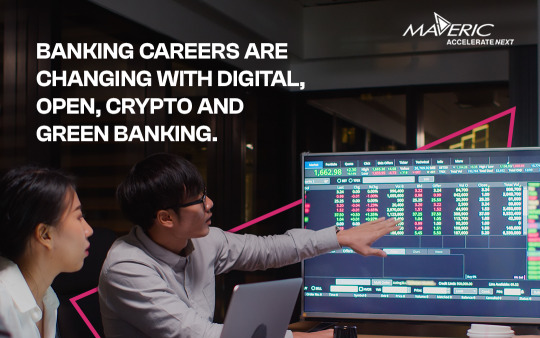
Over the last five years, the banking sector has experienced a significant transformation globally, primarily driven by advances in financial technology (Fintech). Fintech has introduced new challenges, opportunities, and risks, reshaping how financial products and services are delivered and how consumers interact with their money. The integration of Fintech in the financial system has given rise to global digital technology platforms, providing innovative financial products and services to end customers. However, traditional banks have faced challenges in assimilating these technologies simultaneously, leading to an increased need for unique expertise and technology understanding to navigate the complex future.
The Evolution of the Banking Sector
Several key trends have marked the evolution of the banking sector over the last five years:
Digital Transformation: Banks have shifted towards digitizing their operations and customer interactions. This includes digital onboarding, mobile banking apps, online transactions, and personalized customer experiences.
Fintech Disruption: Fintech companies have emerged as formidable competitors to traditional banks, offering innovative products and services that attract a growing customer base.
Open Banking: Open banking initiatives have gained traction, allowing third-party Fintech providers to access customer data with consent. This fosters collaboration between banks and Fintech firms, leading to enhanced services.
AI and Automation: Banks have increasingly adopted artificial intelligence (AI) and automation to streamline processes, improve customer service, and detect fraud.
Blockchain and Cryptocurrencies: The rise of blockchain technology and cryptocurrencies has sparked discussions about the future of financial transactions and the potential disruption of traditional banking models.
Regulatory Changes: Regulatory bodies have been adapting to the challenges and opportunities presented by Fintech, developing frameworks to ensure consumer protection and financial stability.
Navigating the Complexities of the Banking Sector
The banking sector requires professionals with unique expertise and a deep understanding of financial technology to navigate the complex future. The convergence of banking and technology calls for individuals who can bridge the gap between traditional banking practices and the digital landscape.
Here are some of the critical careers in the Banking Technology and Fintech sector:
Fintech Product Manager:
a. Responsibilities: Developing and managing innovative Fintech products and services, analyzing market trends, conducting competitor analysis, and collaborating with cross-functional teams for product implementation.
b. Skillsets: Strong product management skills, knowledge of Fintech trends, understanding of customer needs, and data-driven decision-making.
Data Scientist in Banking:
a. Responsibilities: Analyzing complex financial data, building predictive models, identifying patterns and trends, and providing data-driven insights to enhance decision-making.
b. Skillsets: Proficiency in data analysis, statistical modeling, machine learning, programming languages (Python, R), and finance domain knowledge.
Cybersecurity Analyst:
a. Responsibilities: Protecting banking systems and customer data from cyber threats, conducting risk assessments, implementing security measures, and responding to security incidents.
b. Skillsets: Knowledge of cybersecurity frameworks, ethical hacking, threat detection, incident response, and continuous monitoring.
Digital Marketing Manager:
a. Responsibilities: Developing and executing digital marketing strategies, managing online campaigns, analyzing customer behavior, and optimizing customer acquisition and retention.
b. Skillsets: Digital marketing expertise, data analytics, knowledge of marketing automation tools, and understanding of customer journey mapping.
Blockchain Developer:
a. Responsibilities: Designing and developing blockchain-based solutions, implementing smart contracts, and ensuring the security and scalability of blockchain networks.
b. Skillsets: Proficiency in blockchain platforms (Ethereum, Hyperledger), innovative contract development, cryptography, and decentralized application development.
Prominent Companies Hiring for Fintech Roles and Requirements
Several prominent companies are actively hiring professionals with Fintech and banking technology expertise. Companies like PayPal, Square, Coinbase, Stripe, and Robinhood are at the forefront of the Fintech revolution, offering various roles ranging from product management to software development. These companies prioritize candidates with a solid professional grounding in finance and technology and a passion for innovation and customer-centricity.
Industry-Best Practices for Tech Talent Selection, Training, and Nurturing
Selecting, training, and nurturing tech talent is crucial for fostering innovation and staying competitive in the rapidly evolving Fintech sector. Industry-best practices include:
Proactive Recruitment: Identifying potential tech talent through internships, hackathons, and industry events and nurturing relationships with top talent early on.
Continuous Learning: Providing ongoing learning opportunities to tech professionals, including workshops, certifications, and access to online courses to upskill and stay updated on emerging technologies.
Mentorship Programs: Implementing mentorship programs that pair experienced professionals with junior employees, fostering knowledge transfer and career growth.
Cross-Functional Exposure: Encouraging cross-functional exposure and collaboration to enhance understanding of different banking functions and the overall business.
Innovation Culture: Cultivating an innovation-focused culture that encourages employees to experiment, explore new ideas, and challenge the status quo.
Conclusion
The last five years have witnessed a transformative global journey for the banking sector, driven by Fintech advancements. The industry requires professionals with unique expertise and technology understanding to navigate the complex future. Fintech product managers, data scientists, cybersecurity analysts, digital marketing managers, and blockchain developers are some of the critical roles shaping the future of banking technology and Fintech. Prominent companies like PayPal, Square, and Coinbase are actively hiring for such positions, emphasizing a combination of finance and technology expertise. Organizations can continuously upskill their workforce and stay ahead in this dynamic and competitive landscape by implementing industry best practices in selecting, training, and nurturing tech talent.
About Maveric
Starting in 2000, Maveric Systems is a niche, domain-led Banking Tech specialist partnering with global banks to solve business challenges through emerging technology. 3000+ tech experts use proven frameworks to empower our customers to navigate a rapidly changing environment, enabling sharper definitions of their goals and measures to achieve them.
Across retail, corporate & wealth management, Maveric accelerates digital transformation through native banking domain expertise, a customer-intimacy-led delivery model, and a vibrant leadership supported by a culture of ownership.
With centers of excellence for Data, Digital, Core Banking, and Quality Engineering, Maveric teams work in 15 countries with regional delivery capabilities in Bangalore, Chennai, Dubai, London, Poland, Riyadh, and Singapore.
0 notes